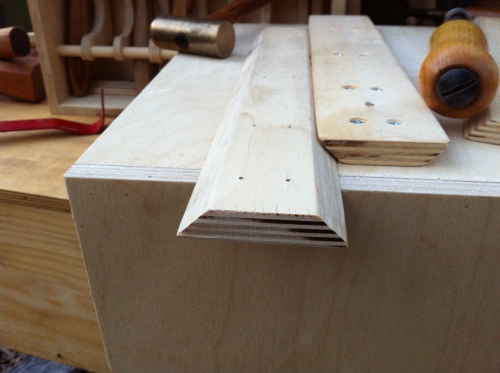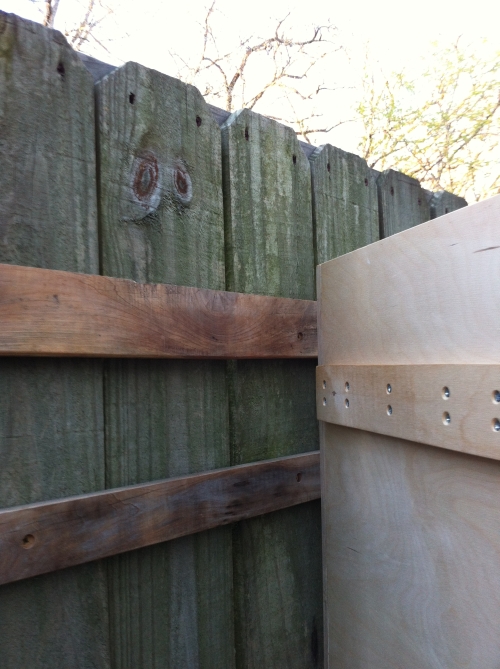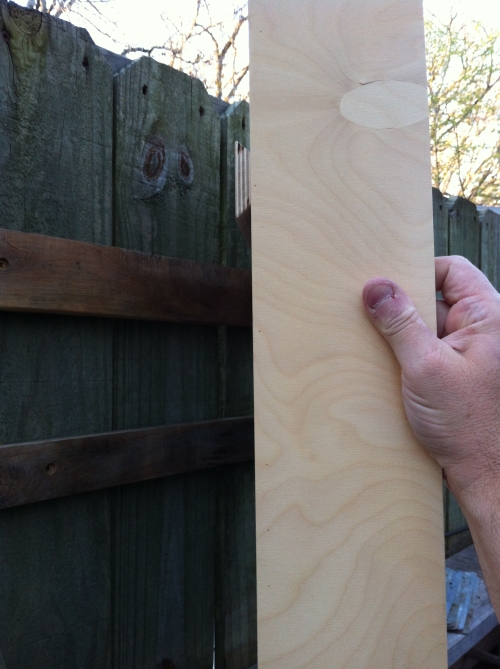In my pursuit of better tool storage, so far I have ignored my worst woodworking flaw. I will grab a tool, use it, and then place it on the nearest convenient surface when I am through with it. Eventually the mess takes over, finding tools is unbearable and tables full of sharp tools can become rather dangerous.
I am rather satisfied with my current portable tool container designs but I have ignored tool management that would be more convenient for a shop. So now my attention is on better tool containers for the workshop.
I have ignored the large carpenters box and the wall mounted tool rack. My back problems are nearly gone, thanks to tai chi, but I still fear the large floor box. Too much leaning over, and too heavy to carry. The thought of a tool rack built kind of like a grandfathers clock crossed with a dolly seems a lot more convenient, but I will put that idea away for a while. The wall mounted tool rack is one of the most lovely things a woodworker can have, but it is in one place, and either it is almost a peg board in a box, or it is a bit hard to add more tools to. Often it has been adapted for a particular set of tools, and changing one out is going to throw off everything.
However, the wall mounted tool rack has several huge advantages. The tool is right there by your worktable and you can see it. That is a huge advantage. It is more efficient for space than a pegboard and a lot prettier. If it is well designed, you can reach and replace tools with ease. If all of your tools can be reached easily and replaced easily on a tool rack that is close by and where you need it, then it is possible to develop much better work habits that I currently have.
So here are my tool rack ideals. Large enough to hold a set of tools for a specific purpose and able to be placed right where it is needed. Small and light enough to be able to be carried. All tools must be visible, the sharp end hard to contact, but where you can see the sharp end. All tools must be able to be removed with ease and replaced with ease. The tool rack should be reasonably attractive and still easy enough to update or replace when things change. Ideally since I work outside, the box should be water resistant if not waterproof.

Here are a pair of my new tool racks. The one on the left is for putting by a lathe, the one on the right is a set of my most commonly used tools.
So far they are unfinished and a bit rough to tell the truth. They are pure prototypes and contain quite a few errors and oddities that I would not repeat if I were doing them over. They work, and are pretty enough, so I am going to finish them and keep them at least for a while. Truthfully they are so convenient that I will probably be using them for years to come.
I also decided that a tool rack should hold the tools securely if bumped or if placed flat on a table. Here is a rack flat on a table.
Here is the same rack with the tools held vertically.
Now to the French Cleat part.
Here are a pair of French Cleats showing how they fit together. If one is mounted to a wall and one is mounted to a box or picture frame or whatever, then you can hang the box on the wall with great security.
So first you attach the French cleat securely to your box, then you mount one securely to your wall. The Shakers often put a French Cleat along the entire length of every convenient wall in a building. I am planning to put several of them made from cedar, on exterior walls and fences. I love French Cleats.
Here is a French Cleat made of cedar and a lower bar to keep things oriented, mounted on a fence. The box has a matching French Cleat.
Here is a side view showing the shape of the French Cleat.
Here is an empty box mounted on the fence. Soon it will be fitted to be a tool rack.
I still have a lot of fitting and arranging to do. But it gets easier as the tools become handier.
Bob








 A page Dedicated to My Writing
A page Dedicated to My Writing
Bob
Discovered your website this morning, looking for marking gauge ideas.
Love the french cleat concept. I am working from an old house trailer and will add 2 x 4 cleats to the long empty walls.
Thanks for the great concept. I also often work outdoors and need portable tool access.
I have copied every marking gauge style that I have seen. I have also innovated and made a few of my own designs, some good, some bad. The one design that has become a must have marking gauge for me is this one, http://toolmakingart.com/2010/12/07/carving-gauge/.
If I were making one from scratch, I would go to http://www.leevalley.com/US/wood/page.aspx?p=52609&cat=1,41182,48945 and purchase the 1/2″ spear point router plane blade and a 1/4″ straight router plane blade to make it with. This would give you the most stable and easy to set marking gauge that I have experienced while also giving you a router plane variation that is absolutely superior when working corners. The spear point would allow you to angle slice with the grain in almost all cases, and the straight blade would give you a safe edge to avoid cutting too far into a corner.
Bob
Inspired idea! Thank you. I have tumbled to french cleats; but you idea of using self-contained boxes as moveable tool racks in conjunction is a major improvement. Best regards.
Neil